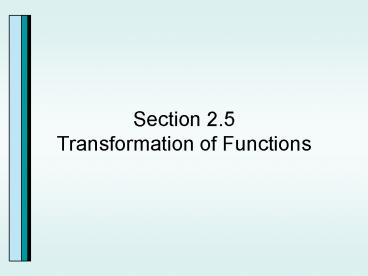Section 2.5 Transformation of Functions - PowerPoint PPT Presentation
1 / 43
Title:
Section 2.5 Transformation of Functions
Description:
Section 2.5 Transformation of Functions Sequences of Transformations A function involving more than one transformation can be graphed by performing transformations in ... – PowerPoint PPT presentation
Number of Views:159
Avg rating:3.0/5.0
Title: Section 2.5 Transformation of Functions
1
Section 2.5Transformation of Functions
2
- Graphs of Common Functions
3
(No Transcript)
4
(No Transcript)
5
(No Transcript)
6
Reciprocal Function
7
- Vertical Shifts
8
(No Transcript)
9
Vertical Shifts
10
(No Transcript)
11
Example
Use the graph of f(x)x to obtain g(x)x-2
12
- Horizontal Shifts
13
(No Transcript)
14
Horizontal Shifts
15
Example
Use the graph of f(x)x2 to obtain g(x)(x1)2
16
Combining Horizontal and Vertical Shifts
17
Example
Use the graph of f(x)x2 to obtain g(x)(x1)22
18
- Reflections of Graphs
19
(No Transcript)
20
Reflections about the x-axis
21
(No Transcript)
22
Example
Use the graph of f(x)x3 to obtain the graph of
g(x) (-x)3.
23
Example
24
- Vertical Stretching and Shrinking
25
(No Transcript)
26
Vertically Shrinking
27
Vertically Stretching
Graph of f(x)x3
Graph of g(x)3x3
This is vertical stretching each y coordinate
is multiplied by 3 to stretch the graph.
28
Example
Use the graph of f(x)x to graph g(x) 2x
29
- Horizontal Stretching and Shrinking
30
(No Transcript)
31
Horizontal Shrinking
32
Horizontal Stretching
33
Example
34
- Sequences of Transformations
35
- A function involving more than one transformation
can be graphed by performing transformations in
the following order - Horizontal shifting
- Stretching or shrinking
- Reflecting
- Vertical shifting
36
Summary of Transformations
37
A Sequence of Transformations
Starting graph.
Move the graph to the left 3 units
Stretch the graph vertically by 2.
Shift down 1 unit.
38
Example
39
Example
40
Example
41
(a) (b) (c) (d)
42
g(x)
Write the equation of the given graph g(x). The
original function was f(x) x2
(a) (b) (c) (d)
43
g(x)
Write the equation of the given graph g(x). The
original function was f(x) x
(a) (b) (c) (d)































